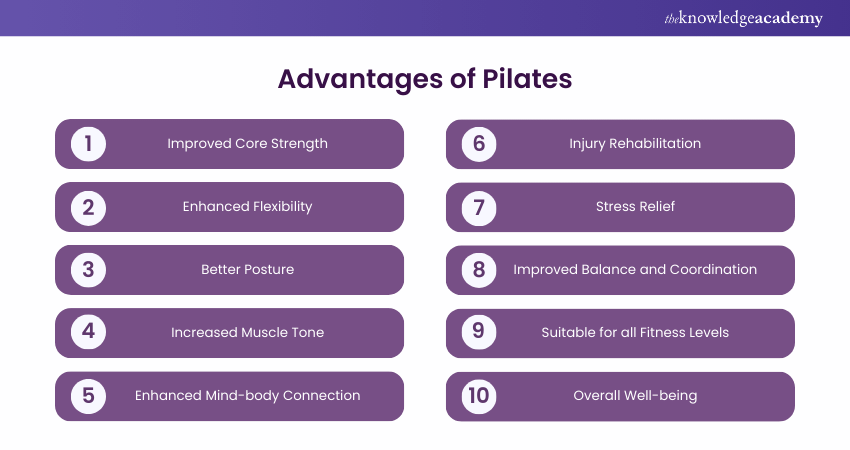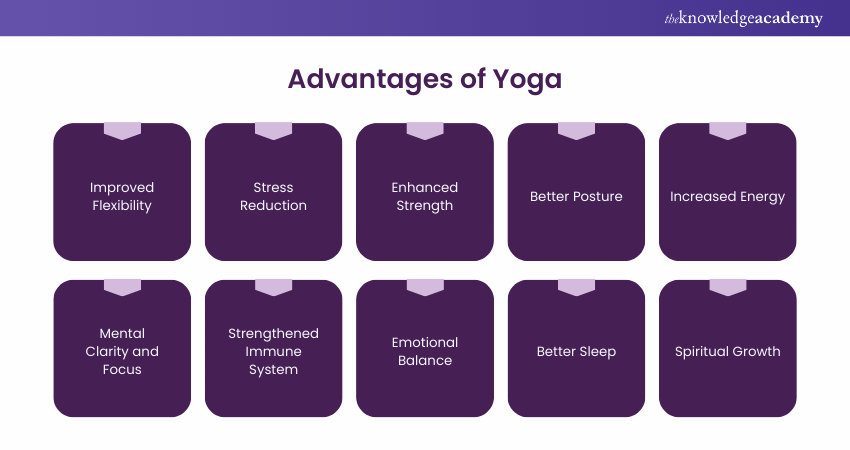We may not have the course you’re looking for. If you enquire or give us a call on +44 1344 203999 and speak to our training experts, we may still be able to help with your training requirements.
Training Outcomes Within Your Budget!
We ensure quality, budget-alignment, and timely delivery by our expert instructors.

Are you caught at the crossroads of fitness and mindfulness, pondering the age-old question: Pilates vs Yoga? These two practices stand as pillars of strength and serenity in the world of wellness, both providing a distinct path to physical and mental well-being.
Pilates attracts individuals looking for a dynamic fitness routine by emphasising core strength and precise movements. Meanwhile, Yoga, deeply rooted in ancient tradition and philosophy, invites practitioners to explore a path of self-discovery and spiritual enlightenment.
For countless fitness enthusiasts, choosing between these two can be a perplexing dilemma. If you find yourself among those torn between the two forms of exercise, fret not; we're here to simply use these techniques for you. By the end of this blog, you'll clearly understand the difference between Pilates vs Yoga.
Table of Content
1) What is Pilates?
2) Advantages of Pilates
3) What is Yoga?
4) Advantages of Yoga
5) Pilates vs Yoga: What’s the Difference?
6) Yoga vs Pilates: Which One to Pick?
7) Conclusion
What is Pilates?
Developed by Joseph Pilates in the early 20th century, Pilates concentrates on fortifying the core muscles of the abdomen, back, and hips with precise movements. The regimen stresses correct posture, breath control, and the synergy between mind and body.
Pilates is designed to boost flexibility, muscle strength, endurance, and posture, contributing to both physical and mental health.
Whether utilising specialised apparatus or a simple mat, Pilates offers a dynamic fitness method that caters to people across all age groups and abilities.
Advantages of Pilates
Pilates offers numerous advantages which extend beyond mere physical fitness. Here are some of the key benefits:

1) Improved Core Strength: Pilates focuses on strengthening the core by targeting deep abdominal, pelvic floor, and back muscles, resulting in improved stability and strength.
2) Enhanced Flexibility: Regular practice of Pilates exercises helps increase flexibility in muscles and joints, improving overall range of motion.
3) Better Posture: This exercise fosters body awareness and correct alignment, contributing to better posture and a lower risk of injury.
4) Increased Muscle Tone: By engaging various muscle groups in a balanced manner, Pilates helps sculpt and tone the body, leading to a leaner and more defined physique.
5) Enhanced Mind-body Connection: This prioritises mindfulness and concentration, nurturing a profound connection between the mind and body.
6) Injury Rehabilitation: Pilates exercises can be adapted to accommodate individuals recovering from injuries, helping to rehabilitate and strengthen affected areas.
7) Stress relief: Focusing on controlled breathing and fluid movements in Pilates can promote relaxation and reduce stress levels.
8) Improved Balance and Coordination: This practice challenges balance and coordination, leading to greater stability and agility in daily activities.
9) Suitable for all Fitness Levels: It offers adaptable exercises suitable for individuals of any age or fitness level, ensuring accessibility to a diverse audience.
10) Overall Well-being: Regular practice of this exercise can contribute to entire well-being by promoting physical health, mental clarity, and emotional balance.
Your journey to wellness starts here! Experience our Healthy Lifestyles Training and build a foundation for a healthier future.
What is Yoga?
Yoga, an ancient practice from India, offers a comprehensive path to wellness. It blends physical poses (Asanas), breath control (Pranayama), Meditation, and moral tenets. It further transcends mere exercise, guiding practitioners on a spiritual quest for unity of body, mind, and soul, fostering self-realisation, serenity, and higher consciousness.
Yoga's diverse styles, from the energetic flows of Ashtanga and Vinyasa to the soothing stillness of Hatha and Yin, all converge on the same objective, thereby harmonising with the supreme essence, cultivating inner tranquillity, and attaining spiritual awakening.
Advantages of Yoga
The Benefits of Yoga are abundant and extend beyond physical fitness. Here are some of those key benefits:

1) Improved Flexibility: Yoga poses (Asanas) gently stretch and lengthen muscles, improving flexibility and joint mobility over time.
2) Stress Reduction: It incorporates breathing techniques (Pranayama) and mindfulness practices that promote relaxation, reduce stress levels, and enhance overall mental well-being.
3) Enhanced Strength: Many Yoga postures require engaging various muscle groups, fostering heightened strength and stamina, especially in areas like the core, arms, legs, and back.
4) Better Posture: Through the practice of Yoga, individuals develop awareness of their body alignment, leading to improved posture and spinal health.
5) Increased Energy: Continuous Yoga practice can boost energy levels and alleviate feelings of fatigue by stimulating circulation and promoting oxygen flow throughout the body.
6) Mental Clarity and Focus: It fosters mindfulness and concentration, which in turn soothe the mind, elevate cognitive abilities, and sharpen focus and mental sharpness.
7) Strengthened Immune System: Stress-reducing benefits of Yoga and its emphasis on deep breathing can support a healthy immune system. This can help alleviate the risk of illness and enhance overall resilience.
8) Emotional Balance: This practice provides a safe space for emotional release and introspection, fostering a sense of balance, resilience, and emotional well-being.
9) Better Sleep: Practicing Yoga before bedtime can promote relaxation and relieve tension, leading to deeper, more restful sleep.
10) Spiritual Growth: For those seeking spiritual fulfilment, Yoga offers a pathway to self-discovery, inner peace, and connection to something greater than oneself.
Enhance your mental and physical well-being with our Yoga Training – sign up today!
Pilates vs Yoga: What’s the Difference?
The difference between Pilates vs Yoga underscores their unique paths toward wellness and self-discovery. While both techniques offer numerous benefits for physical and mental well-being, they differ in several key aspects. The following are the key differences between Yoga vs Pilates:
1) Origin and Philosophy
Yoga emphasises the integration of mind, body, and spirit through the amalgamation of physical postures (Asanas), breathwork (Pranayama), and meditation. Its primary goal is holistic well-being and spiritual growth.
At the same time, Pilates focuses on building core strength, improving flexibility, and enhancing muscular balance and control. It emphasises alignment, stability, and controlled movement patterns to promote overall fitness.
2) Focus
Yoga emphasises the integration of mind, body, and spirit through a combination of physical postures, including asanas, pranayama, and meditation. Its primary goal is holistic well-being and spiritual growth.
On the other hand, Pilates focuses on building core strength, improving flexibility, and enhancing muscular balance and control. It emphasises alignment, stability, and controlled movement patterns to promote overall fitness.
3) Breathing
Breath awareness and control are integral to Yoga practice. Specific breathing techniques (Pranayama) are used to enhance concentration, facilitate movement, and promote relaxation. While breathing is incorporated into Pilates, it is not as central to the practice as it is in Yoga. Pilates typically emphasises lateral breathing, where the breath is coordinated with movement to enhance core engagement and stability.
4) Equipment
Yoga generally requires minimal equipment, with practitioners often using just a mat for practice. However, props such as blocks, straps, and bolsters may be used to support and deepen certain postures.
In contrast, Pilates can be performed on specialised equipment such as a reformer, Cadillac, or chair, which utilises springs and pulleys to provide resistance and support during exercises. Mat-based Pilates exercises also exist and require only a mat for practice.
5) Movement Patterns
Yoga incorporates a wide range of movement patterns, including standing, seated, supine, and prone poses, as well as inversions and balancing poses. Movements flow seamlessly from one posture to another, often in synchronisation with the breath.
However, Pilates typically involves controlled, precise movements that target specific muscle groups. Exercises may be performed in various positions, including lying down, sitting, kneeling, or standing, with a focus on core stabilisation and proper alignment.
While both exercises promote physical fitness and mental well-being, they differ in many ways. Choosing between the two ultimately depends on individual preferences, goals, and needs. Some may prefer the spiritual and holistic approach of Yoga, while others may gravitate towards the core-focused and controlled movements of Pilates. Ultimately, both disciplines offer valuable tools for enhancing overall health and vitality.
Discover the art of healthy living with our comprehensive Nutrition and Fitness Training – join us and begin your journey to vitality!
Yoga vs Pilates: Which one to pick?
Both yoga and Pilates offer unique benefits, and choosing the right one depends on your individual needs and preferences.
Yoga:
a) Yoga emphasises flexibility, balance, and mindfulness.
b) Various styles of yoga cater to different goals, such as restorative yoga for relaxation or acro yoga for partner-based practice.
c) Chair yoga is suitable for those with limited mobility.
d) Always consult an instructor to modify poses based on your abilities and any health conditions.
Pilates:
a) Pilates focuses on core strength, stability, and controlled movements.
b) It’s low-impact and great for older adults or injury recovery.
c) Mat Pilates is equipment-free, while equipment-based Pilates adds resistance.
d) Proper instruction is essential to prevent injuries.
e) Remember to listen to your body and choose the practice that aligns with your fitness level and goals
Unlock the secrets of serenity with our Meditation Course – join us now and begin your journey to inner peace today!
Conclusion
In the timeless debate of Pilates vs Yoga, there's no definitive winner. Pilates enhances core strength and flexibility, while Yoga offers a holistic approach to well-being, blending breath and movement for inner harmony. Ultimately, the choice is personal, reflecting one’s individual health goals and preferences in physical practice.
Become the catalyst for growth with our Life Coach Training – join us now and lead the change!
Frequently Asked Questions

Pilates, while focusing on core strength and alignment, can be as relaxing as yoga. It promotes mindfulness and controlled breathing, similar to yoga, which helps in reducing stress and enhancing relaxation.

The time Pilates takes to tone the body varies, but with consistent practice, improvements can be seen in as little as a few weeks. Full toning benefits often manifest within three to six months of regular sessions.

The Knowledge Academy takes global learning to new heights, offering over 30,000 online courses across 490+ locations in 220 countries. This expansive reach ensures accessibility and convenience for learners worldwide.
Alongside our diverse Online Course Catalogue, encompassing 17 major categories, we go the extra mile by providing a plethora of free educational Online Resources like News updates, Blogs, videos, webinars, and interview questions. Tailoring learning experiences further, professionals can maximise value with customisable Course Bundles of TKA.

The Knowledge Academy’s Knowledge Pass, a prepaid voucher, adds another layer of flexibility, allowing course bookings over a 12-month period. Join us on a journey where education knows no bounds.

The Knowledge Academy offers various Healthy Lifestyles courses, including Yoga course, Active and Healthy Lifestyles Training, and Develop Cognitive Behavioural Therapy Training. These courses cater to different skill levels, providing comprehensive insights into What is Meditation?.
Our Health and Safety blogs cover a range of topics related to Yoga, offering valuable resources, best practices, and industry insights. Whether you are a beginner or looking to advance your Health & Safety knowledge , The Knowledge Academy's diverse courses and informative blogs have you covered.







 Top Rated Course
Top Rated Course




 If you wish to make any changes to your course, please
If you wish to make any changes to your course, please


